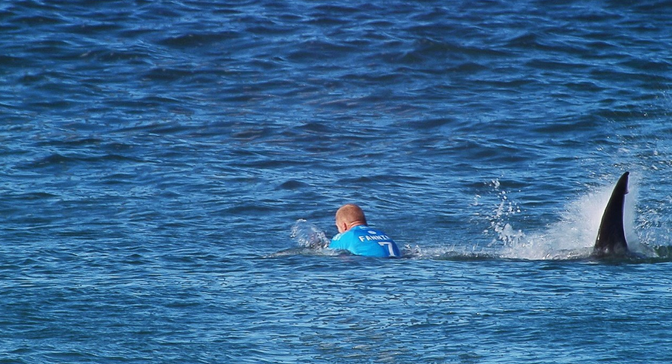A few days ago a surfer, by the name of Mick Fanning, was taking part in a surf competition – sitting on his board out in the waves waiting for his turn – when a Great White Shark attacked him. He was incredibly fortunate that the shark didn’t get its teeth into him. He punched the shark on the back and frantically struggled to get back on his board whilst a fellow surfer and safety stewards raced to his aid. And the whole frantic episode was broadcast live on TV.
It is stunning footage which you can see here if you haven’t yet.
After Fanning returned to the beach there was a media scrum which almost certainly rivaled the attention he has received from winning multiple championships and world titles. This was a truly remarkable story and everyone in the press wanted to hear from the man himself.
So a press conference was called. And that is when the PR damage started.
Getting the brand associations wrong
 At the press conference, Fanning and his would-be rescuer, fellow surfer Julian Wilson, perched on stools in front of a phalanx of media. Behind them were a couple of Rip Curl boards propped up against the wall. On Fanning’s head, a Rip Curl cap. In his hand – throughout the press conference – a can of Red Bull. Wilson was similarly adorned.
At the press conference, Fanning and his would-be rescuer, fellow surfer Julian Wilson, perched on stools in front of a phalanx of media. Behind them were a couple of Rip Curl boards propped up against the wall. On Fanning’s head, a Rip Curl cap. In his hand – throughout the press conference – a can of Red Bull. Wilson was similarly adorned.
As this Sydney Morning Herald piece opines, the branding was heavy-handed at best and distasteful at worst. This story is incredible and was bound to garner world-wide interest. The brands involved did not need to ram their association with these two athletes down everyone’s throats.
But I wonder whether this was to do with the brands (and in fact when the author of the piece talks about ‘brands’ who exactly does he mean)?
What can a brand expect from an athlete?
Athletes are selected at ambassadors for brands because they are brilliant at what they do – surfing, cycling, running, pole-vaulting… whatever. They are not necessarily great at public relations. That isn’t their job. So it is possible that the athletes believe they are doing the right thing when in fact they are ‘over-doing’ the brand association. It is also possible that the brands, at an event like the one Fanning and Wilson were competing at, are represented by over-eager PR people who want to do the right thing and don’t realise that their efforts can back-fire.
It is always difficult to create guidelines for brand ambassadors (and over-eager PR people) that will cover every situation. Certainly had the headline story been that Fanning or Wilson had won the surf event sans infiltration by a dangerous predator, then appearing on the podium displaying their brand associations prominently would be acceptable. In fact it would be appropriate.
But in this case – irrespective of whether it was the athletes themselves or the brands or someone employed by the brand to work for them on PR – the branding felt false which undermined the story and, we think, had a detrimental effect on the brands. But how do you put that in a handbook or set of guidelines?
Talk about stories rather than issuing guidelines
Our suggestion is to talk about different types of stories with the athletes. There are some stories where celebrating the brand is entirely appropriate (winning is one such story). And others where it is sensible to be more human and leave the brands to one side for a moment (coming close to being eaten by a great white shark live on TV, for example).
There will never be a perfect answer to this, but there is definitely not a one-size-fits-all way of doing things.

Leave a Comment